Photographed by Paige Green
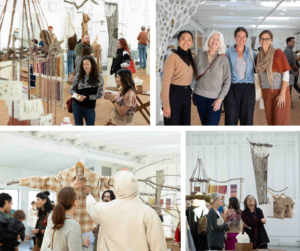
Today’s clothing relies on transnational supply chains, petroleum-based materials, and land and labor exploitation. But what if your clothing could build ecosystem and community resilience while regenerating healthy soil and land?
From November 10-16, 2023, Fibershed hosted its ‘Borrowed from the Soil’ Design Exhibition, which explored a future vision where the way we produce and use one of our most basic human necessities – clothing — can support the longevity and health of our local ecosystems and communities. This farm-to-closet exhibition explored the process behind the production of locally grown and made clothing that connects people to California farms, mills, and designers. This exhibition followed the journey from cotton and flax fields to sheep ranches and alpaca farms through the transformations of raw materials into beautiful textiles, embedding into the design process an understanding of how these materials can be healthfully returned back into our soils. We invited community members to help build a collective understanding of the interconnectedness between material, design, and consumer choices, and the land and people whom these choices impact.

For information on the participating designers, view the exhibition program here (best viewed on mobile device).
For those of you who were unable to view the exhibition live, we wanted to give you a virtual tour below:
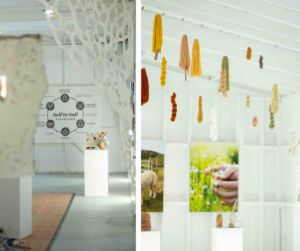
Farming & Fiber
Soil plays a vital role in the Earth’s terrestrial ecosystems, and its health directly impacts human and non-human life. Soil contains an intricate network of various life forms, minerals, organic matter, nutrients, water, air, and other gases. As one of the major carbon pools on Earth, soil holds a crucial role in our ability to sequester (or draw down) carbon from the atmosphere and help mitigate climate change. Currently, our atmosphere has too much carbon, while the carbon content of soils around the world has been significantly depleted. Engaging with agriculture can help to balance the carbon cycle and stabilize climate through carbon farming, which moves carbon from the atmosphere into plant life and soil ecosystems.
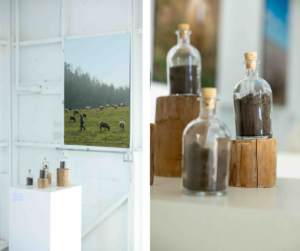
In the exhibition, participants were able to interact with the four main natural fibers grown and processed in our California Fibershed region: wool, cotton, alpaca, and flax/linen.
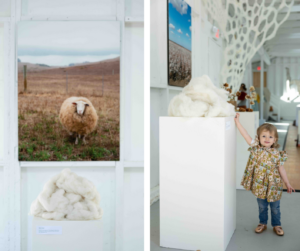

How natural fibers are grown defines whether they contribute to or ameliorate the global climate crisis. Fiber farming has the ability to be done in a manner that enhances the drawing down of atmospheric carbon into the soil. This ‘enhanced photosynthetic capture’ is done through natural and time-honored processes that are also known to create dynamic and highly productive soils. When fiber farming is conducted to enhance organic soil carbon levels and ensure the clean recharge of groundwater; and when farming is implemented by using little to no synthetic molecules to fertilize or control weeds and pests; it can be a significant contributor to the enhancement of earth’s biosphere health.
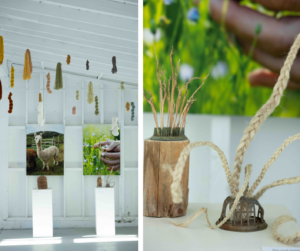
Fiber Processing
California is the largest wool producer in the United States and we manufacture less than 1% of our wool supply into yarn. We predominantly send raw, low-cost fibers to other countries that add value to our material and see economic benefits from those manufacturing processes. Over 900,000 pounds of the wool produced in California is soft enough to be considered next-to-skin quality and over two million pounds of our coarser wool could be spun and manufactured into durable goods and outerwear, or felted for use in a range of textile applications.
Since 2013, Fibershed has worked to establish an understanding of California’s wool supply and demand for wool goods. We have both mapped and advocated for the bio-circular economic opportunities that are putting the “Restoration Economy” into being. We will continue to coordinate stakeholders, build external capacity with entrepreneurs, and raise capital with partners to continue to bring more manufacturing components to our soils.
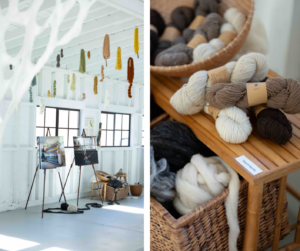
Designers, Makers, & Garments
Design School Partnerships
Fibershed collaborates with design schools in Northern California and beyond to help shape the future of fashion. Through these collaborations, we connect the next generation of sustainable fashion designers to regional textile material sourcing and supply chains. Students gain an understanding of how a soil-to-soil approach is not only urgently needed, but possible.
This year, Fibershed partnered with the Fashion Merchandising and Management Program (FASH) at California State University, Sacramento (CSUS). This program prepares students for careers in the fashion industry, emphasizing the contemporary and historical ways of meeting consumers’ economic, physiological, aesthetic, psychological, sociological, and cultural needs. The partnership with Fibershed is the start of a new direction for FASH. Fibershed’s support of students and sustainability initiatives has been a significant step in fostering sustainable knowledge and practices within the program. This partnership has prompted reflection on CSUS’ position amongst the region’s farmers, producers, designers, and lawmakers. Faculty aim to strengthen the program’s relationship with the area and are committed to incorporating sustainability into fashion education. Donations of regional materials, dyestuffs, and educational opportunities provided by Fibershed have significantly impacted the students participating in the design challenge. The outcomes created with these resources model alternative design and production methods, now visible to all students in the program.
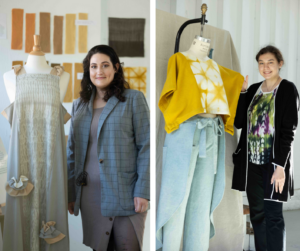
FASH students Kayley Kirkaldie and Andrea Armstrong completed a research assistantship with Professor Emily Oertling, Ph.D. in summer 2023 that supported the design and construction of the garments displayed here. See Artist Statement section of the program for more information on each student designer.
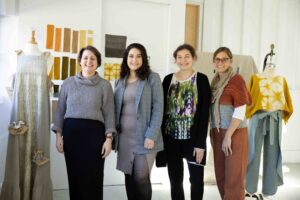
Fibershed’s Year-Long Design Challenge

All of the other designers featured in this exhibition are part of Fibershed’s year-long “Borrowed from the Soil” Design Challenge. Fibershed launched its year-long Design Challenge in March 2023 as an opportunity for textile designers and makers in Northern and Central California to explore a new soil-to-soil vision for the future of our material culture. Throughout this 12-month challenge, designers had the opportunity to create prototypes with regionally produced natural fibers and dyes, while exploring three main Design Focus Areas: Zero Waste Design, Longevity, and Compostability.
See Artist Statement section of the program for more information on each designer.

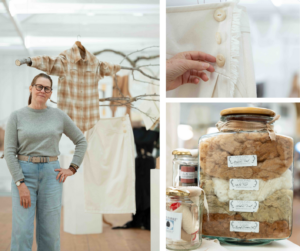
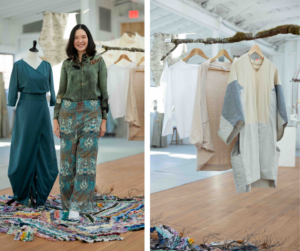
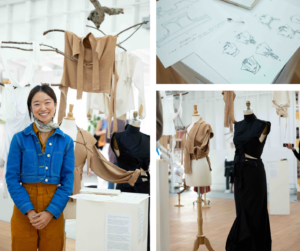
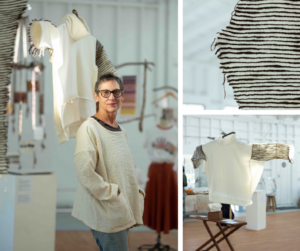
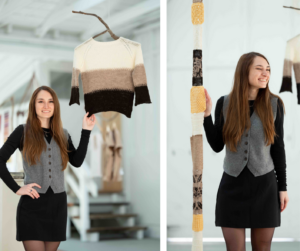
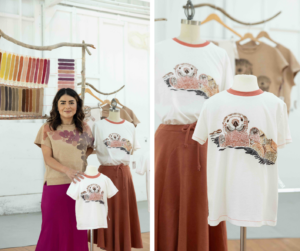
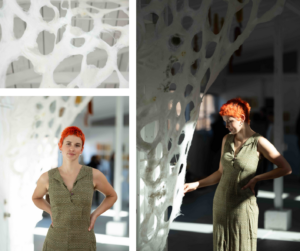
Compostability: Countering the Legacy of Microplastic Pollution from Synthetic Textiles
Microplastics are reported with increasing concentration in our oceans, lakes, rivers, tap water, rain and clouds, soil, indoor and outdoor air, and inside of animal and human bodies. Like other plastics, microplastics accumulate in ecosystems and bodies because they do not biodegrade.
This accumulation of microplastics reflects a growing disconnect between human-made materials and the natural cycling of carbon and other elements through our biosphere. With the escalating use of fossil fuel-derived synthetic (plastic) fibers in our textile and fashion industries, over 60% of the content of textiles globally is currently plastic. According to leading microplastic researchers at the San Francisco Estuary Institute, “Fibers…are one of the most ubiquitous forms of microplastic pollution reported globally” (Moran et al., 2021. SFEI). Microplastic fibers are primarily derived from the continual release of fibers from synthetic textiles during wearing/use, washing, and at the end of their use/disposal.
Because fibers are continually released from our textiles, we need to consider that all of our textile materials are slowly and consistently making their way into our ecosystems, and by extension, into our bodies. When materials are compostable, they are able to decompose into natural, nontoxic components at a specifically defined rate, consistent with other organic materials. Natural fiber materials that are not treated with harmful chemicals can easily cycle through our ecosystems like other organic materials.
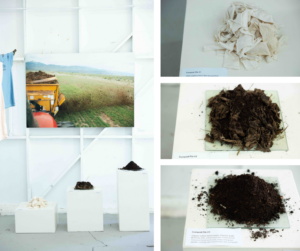
Fibershed has conducted textile compost trials at our Learning Center outside Point Reyes Station, California, since June 2022. In partnership with Harvest & Mill, a local clothing manufacturer that uses untreated and naturally dyed organic cotton textiles to make its clothing, we have been incorporating manufacturing textile waste scraps into our compost piles to demonstrate the ease with which cotton decomposes in compost, and its ability to help nourish the soils of our gardens. Compostability becomes a lens through which we can understand parameters for healthy textile products whose contents can be safely taken in and decomposed within our ecosystems across their lifespan, including the making of soil-enriching compost at the end of a long and useful material life.
Want to learn more? Read The Hidden Story of Plastics in Our Clothes

Thank you for following along on our Fall ‘Borrowed from the Soil’ Design Exhibition. We will be hosting a Spring Exhibition in 2024.
If you would like to learn more about fiber and dye systems, climate beneficial agriculture, Fibershed initiatives, and more…
- Read our blog
- Join our email newsletter
- Follow us on Instagram, LinkedIn, or Facebook
- Read: “Fibershed: A new ‘farm-to-closet’ vision for the clothes we wear” by Fibershed Founder and Executive Director, Rebecca Burges
- Listen to the Weaving Voices podcast
